Wat Phra Singh in Chiang Mai, Northern Thailand. King Ananda
Mahidol (Rama VIII), the older brother of the late King Bhumibol
Adulyadej (Rama IX), bestowed on it the status of Royal temple of the
first grade in 1935.There are several magnificent and very old temples
within the walled old city of Chiang Mai, with the Wat Phra Singh being
one of the most attractive.The temple, which is also known as “The
Monastery of the Lion Buddha” or “The temple of the Lion Buddha” is an
active temple, with hundreds of monks and novices living there.Wat Phra
Singh (Temple of the Lion Buddha) is an important Buddhist monastery and
temple on the west side of Chiang Mai, Thailand. Founded in the 14th
century, it houses two medieval Buddha statues.
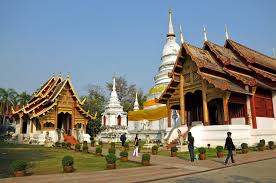
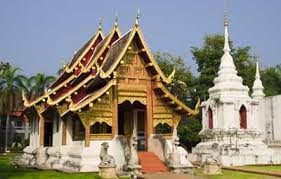
Next
to the ubosot, in a line with the wiharn, is a large whitewashed pagoda
(chedi). Next to it is a small but very ornate Wiharn which is worth a
closer look. The outside is decorated in gold and ocher in a style which
is ornate but without the gaudiness of many other temples.Chiang Mai's
most revered temple, Wat Phra Singh is dominated by an enormous,
mosaic-inlaid wí·hăhn (sanctuary). Its prosperity is plain to see from
the lavish monastic buildings and immaculately trimmed grounds, dotted
with coffee stands and massage pavilions. Pilgrims flock here to
venerate the famous Buddha image known as Phra Singh (Lion Buddha),
housed in Wihan Lai Kham, a small chapel immediately south of the chedi
to the rear of the temple grounds.This elegant idol is said to have come
to Thailand from Sri Lanka and was enshrined in 1367, and the chapel is
similarly striking, with gilded naga (serpent) gables and sumptuous
lai·krahm (gold-pattern stencilling) inside.Despite Phra Singh's exalted
status, very little is known about the Phra Singh image, which has more
in common with images from northern Thailand than with Buddha statues
from Sri Lanka. Adding to the mystery, there are two nearly identical
images elsewhere in Thailand, one in the Bangkok National Museum and one
in Wat Phra Mahathat Woramahawihan in Nakhon Si Thammarat. Regardless
of its provenance, the statue has become a focal point for religious
celebrations during the Songkran festival.As you wander the monastery
grounds, note the raised temple library, housed in a dainty teak and
stucco pavilion known as Ho Trai, decorated with bas-relief angels in
the style of Wat Jet Yot. The temple's main chedi, rising over a classic
Lanna-style octagonal base, was constructed by King Pa Yo in 1345; it's
often wrapped in bolts of orange cloth by devotees.
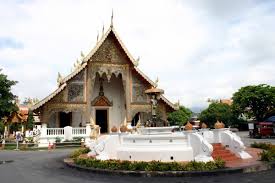
The decoration inside is also quite rich. There is a brocade-like gold and red pattern on parts of the roof and back wall behind the altar. On the altar here (and not on the altar of the main wiharn) sits the Phra Singh Buddha image from which the temple takes its name. "Phra" is Thai for a priest or cleric and also used to refer to Buddha images. "Singh" means lion, but may be a corruption of the Thai word for Sri Lanka, where the image is supposed to come from.Wat Phra Singh was founded in the fourteenth century to enshrine the ashes of King Kam Fu.From Wat Phra Singh, you might want to go on to Wat Chedi Luang, which is just a short walk away. Another important temple within the walls is the oldest: Wat Chieng Man. It's another short walk away, near the Chang Puak gate and the Thai Airways ticket office.
History:-Construction
on Wat Phra Singh began in 1345 when King Phayu,[2]:226–227 the fifth
king of the Mangrai dynasty, had a chedi built to house the ashes of his
father King Kham Fu. A wihan and several other buildings were added a
few years later and the resulting complex was named Wat Lichiang Phra.
When, in 1367, the statue of Phra Buddha Singh was brought to the
temple, the temple complex received its present name. During restoration
works in 1925, three funerary urns were discovered inside a small
chedi. It was assumed that these contained royal ashes. The urns have
since been lost. From 1578 to 1774 the Burmese ruled Lanna and in this
period the temple was abandoned and came under serious disrepair. It was
only when King Kawila assumed the throne as King of Chiang Mai in 1782,
that the temple was restored. King Kawila had the ubosot built and the
chedi enlarged. Later successors restored the Wihan Lai Kham and the
elegant Ho Trai (temple library).
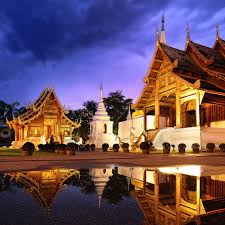
The whole temple complex underwent extensive renovations under the famous monk Khru Ba Srivichai during the 1920s. Many of the buildings were again restored in 2002.
Wat Phra Singh was built in 1345 by King Pha Yu for the ashes of his faher, King Kham Fu. It may have been the first monastery to house the Emerald Buddha, which later resided in Wat Chedi Luang and is now enshrined in Wat Phra Kaew, Bangkok. The temple is named for the Buddha image it housed in 1367, the Phra Singh (Lion Buddha).The temple-monastery fell into disrepair as Chiang Mai's population declined in the 18th century, but restoration began in the early 19th century under Chao Kawila. The work continued under his successor, Chao Thammalangka, who commissioned the murals in Viharn Lai Kham.
What to See at Wat Phra Singh:-Wat Phra Singh is an important temple and a major monastery, housing 700 friendly monks who often approach tourists to practice their English.The largest building is Viharn Luang (viharn = assembly hall), rebuilt in 1925 on the site of a 14th-century original and extensively restored in 2008. The three-aisled interior is impressive, its high red roof supported by round white columns. It houses Phra Chao Thong Tip, a large image of the seated Buddha cast of gold and copper in 1477.A smaller assembly hall, the beautiful Viharn Lai Kham (Gilded Hall), was built around 1345 and renovated in the early 19th century. It is considered a fine example of Lanna monastic architecture. Inside is Phra Singh (the Lion Buddha), an original 14th-century treasure except for the head (which was stolen in 1922). The walls are covered in murals (dating from the 1820s) illustrating Jataka tales and other stories. The round pillars and the wall behind the Buddhas are decorated in red-and-gold patterns.Perpendicular to Viharn Lai Kham is the ubosot, built in 1806. The opulent decoration on its gables include abstract mandala designs. Inside is an ornate ku (Buddha throne).
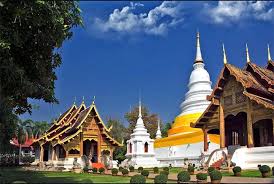
The little monastic library (1477) has a stone base to protect precious manuscripts from flooding and pest. It is decorated with devata or thewada (Buddhist spirit) figures in high relief. There are also several chedis on the temple grounds, the largest one dating from 1345 and enlarged considerably since.
No comments:
Post a Comment